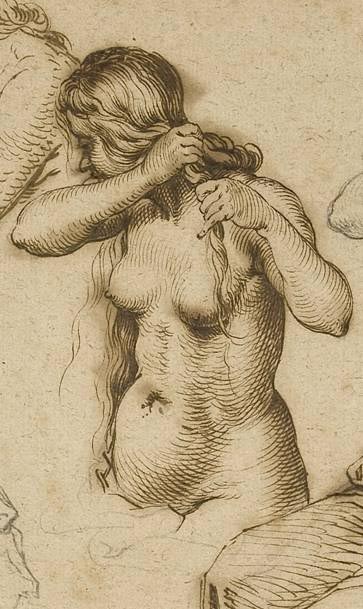
Jacques de Gheyn II (1565-1629)
Detail of drawing of nude women doing their hair
Brussels, Koninklijke Musea voor Schone Kunsten van België
From the museum website
This autumn the Rembrandt House Museum is showing almost a hundred seventeenth-century Dutch drawings from the collection of Jean de Grez in the Royal Museums of Fine Arts in Brussels. Landscapes and townscapes, portraits, history paintings and biblical scenes, genre works and figure studies bring the age of Rembrandt back to vivid life-pearls of the art of drawing by celebrated artists like Hendrick Goltzius, Pieter Saenredam, Rembrandt and Adriaan van Ostade. The exhibition is superb evidence of the phenomenal quality of seventeenth-century Dutch drawing.
The Jean de Grez Collection
The drawings come from the collection of Jean de Grez (1837-1910) of Breda, which his widow donated to the Belgian state in 1911. At a stroke, the Royal Museums of Fine Arts in Brussels found themselves in possession of more than four thousand drawings by old masters, with works from the Dutch Golden Age as the most important and by far the largest group. Although the De Grez Collection is highly regarded by experts and individual masterpieces are frequently loaned out for international exhibitions, it is not widely known to the general public. Now, for the first time in forty years, a magnificent selection of works from the De Grez Collection, some of which have never been shown before, can be admired in Amsterdam.
Dutch drawings in the seventeenth century
The Golden Age was a time when trade, scholarship and culture reached unprecedented heights in the Netherlands. The prosperous middle classes, who took a keen interest in art, began to collect both paintings and drawings. The buyers preferred detailed, finished drawings, works of art in their own right, preferably in colour. These they kept in portfolios, to be brought out and admired from time to time. Drawings like these were also extremely popular with eighteenth and early nineteenth-century collectors. An interest in sketchier drawings, which came to be regarded as the most personal expression of an artist’s genius, did not develop until the latter part of the nineteenth century.
Highlights of the exhibition
The highlights of the exhibition include Nude studies of a woman by Jacques de Gheyn (1565-1629) and the classical scene Sine Cerere et Baccho friget Venus (‘Love cools without food and wine’) by Hendrick Goltzius (1558-1617). The brightly-coloured River View by Hendrik Avercamp (1585-1634) is a little gem, as is the View of ‘s-Hertogenbosch drawn by Pieter Jansz. Saenredam (1597-1665) in the summer of 1632. The exhibition also boasts splendid examples of Italian landscapes, such as the View of the Colosseum by Jan Asselijn (1610/14-1652) and the Ruin by Barthelomeus Breenbergh (1598/60-1657). The Interior of an Inn of 1680 by Adriaan van Ostade (1610-1685) is a veritable ‘painting on paper’.
Catalogue
Tekeningen uit Nederlands Gouden Eeuw in de verzameling van Jean de Grez
Stefaan Hautekeete
Brussels (Royal Museums of Fine Arts of Belgium) and Ghent (Uitgeverij Snoeck) 2006
